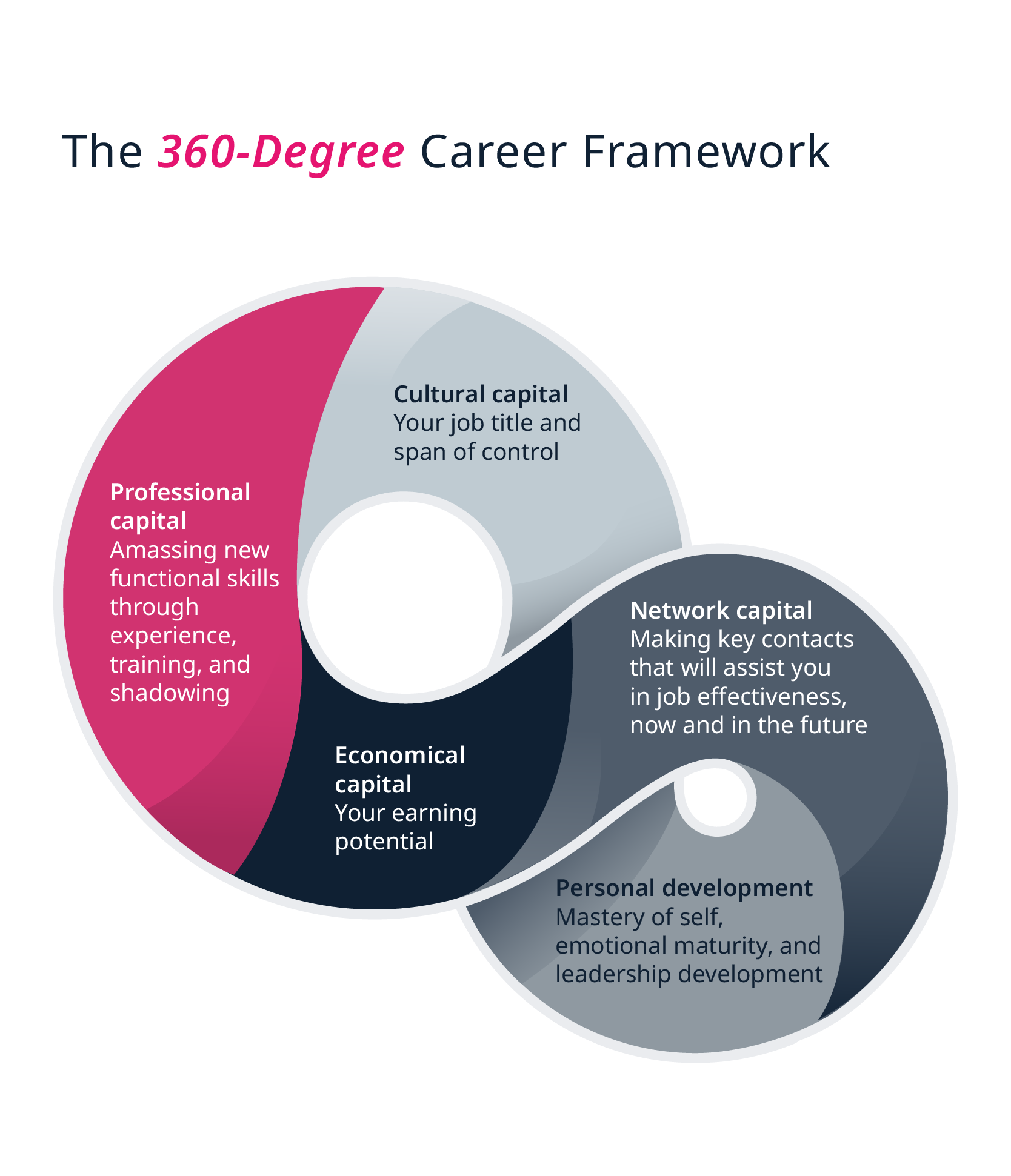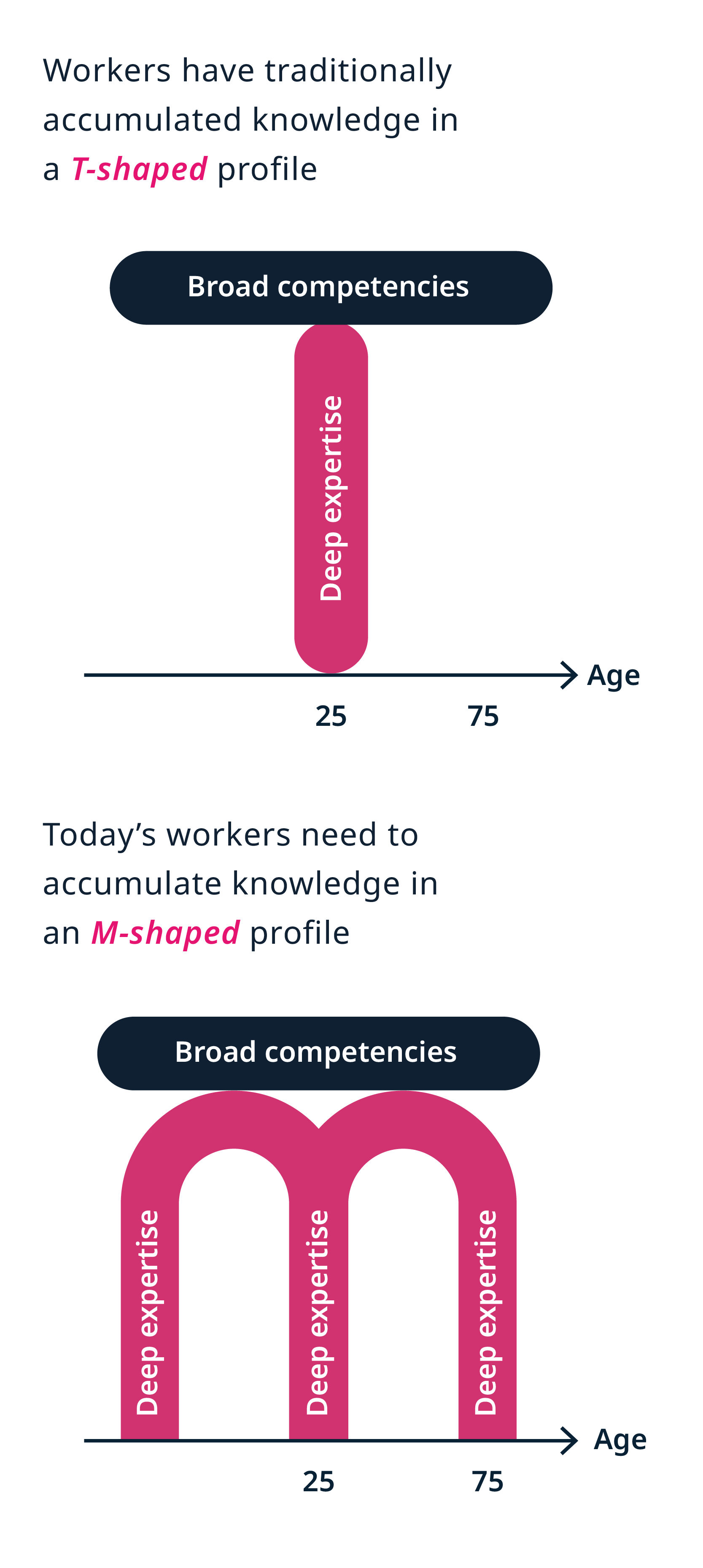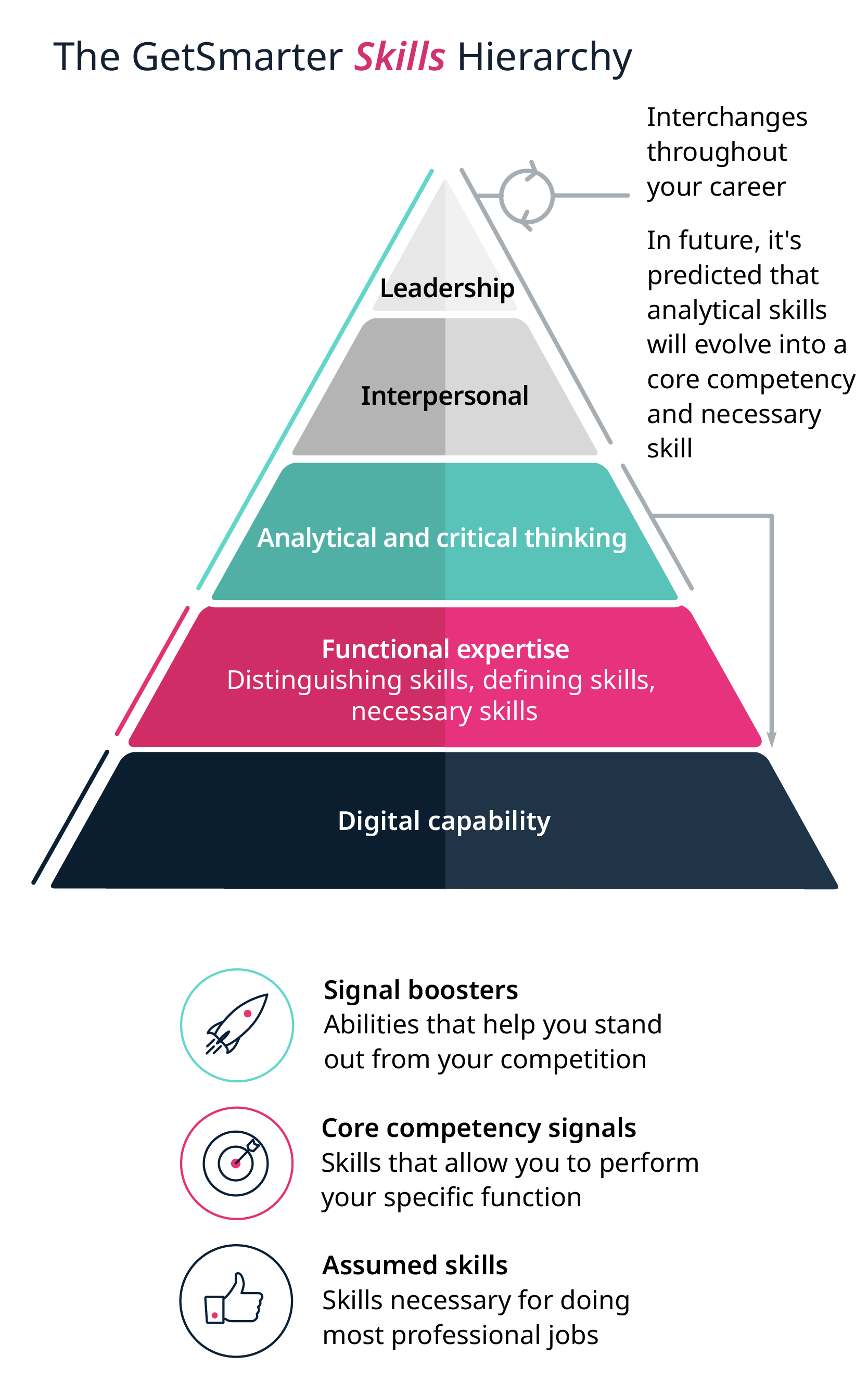The 360-Degree Career Framework: Plot Your Path and Progression
The COVID-19 pandemic and the resultant need to work and operate remotely has triggered wide-scale digital disruption, changing both personal and professional priorities. With the events of the past two years placing immense financial, emotional, and physical pressure on people across the globe, employees are now searching for more fulfilling work and rewarding careers within the new ways of working. The pandemic also emphasized two crucial career lessons: Firstly, human capital, interpersonal skills, and high-value relationships will help future-proof your worth in the workplace. Secondly, you should no longer rely on a traditional career path for advancement. The good news: Thanks to the greater flexibility and hybrid working opportunities enabled by this global crisis, you have the freedom to design a livelihood that you truly enjoy.1
The question is, how do you define a career path that fulfills your unique personal and professional needs in this new working world? The answer: GetSmarter’s Career Guide 2022: A 360-Degree Framework. With its modern approach to professional development, it will empower you to explore career breadth and length, and harness role diversity and market mobility to unlock greater work opportunities.
It will empower you to explore career breadth and length, and harness role diversity and market mobility to unlock greater work opportunities.
The framework incorporates three pillars: professional capital, personal development, and network capital. These work as connected growth levers; they constantly influence one another within an integrated professional growth ecosystem. Your aim is to leverage these pillars to unlock economic and cultural capital. The framework is a blueprint for career success, offering guide rails to help you safely plot a rewarding career path.

To craft your path successfully using this 360-framework, there are several points to keep in mind, including utilizing lateral mobility, diversification, and a bespoke skills plan.
Embrace lateral moves as progression
Even before the pandemic and the onset of ‘the great resignation’, non-linear careers were on the rise. Over the past few decades, the crucial period of an employee’s productivity and earning power (from ages 25 to 50) has transformed from a time of relative stability to a time of discovery, restlessness, and exploration.2
Career flux has become the norm and the pandemic only intensified this. Journalist and author Farai Chideya calls it the age of the “episodic career”, where experiences inform and build on one another, creating growth opportunities and new potential for fulfillment.3
As part of GetSmarter’s The Future of Work Is Here report, over 8,000 respondents in 106 countries were surveyed, building on insights gathered from more than 100,000 students over the past 12 years. According to this report, most respondents saw their career path as “fluid and changing frequently” and over half of the surveyed professionals said they might switch job function or business area completely to advance. Of these respondents, 63% of Generation Z and 54% of millennials say they’re either “somewhat likely” or “very likely” to change professions in the next 12 months.
These career moves help individuals continuously upgrade their skills, raise their income, and build track records that translate into professional value. However, it’s also the work experience itself – the hard-earned skills and knowledge you gain on the job – that offers real worth. Research shows that work experience contributes 40 to 60% of a worker’s human capital.4 The same study showed that those who take on new roles that involve bigger changes or challenges receive bigger rewards, both in terms of financial gain and experience. It is this willingness to change to new teams, departments, roles, businesses, and industries that counteract the likelihood of job losses and lack of vertical mobility created by the pandemic.5
Research shows that work experience contributes 40 to 60% of a worker’s human capital.4
To succeed going forward, you’ll need to sidestep the traditional career path and become more adaptable and versatile. The trajectory, for many, will be made up of a range of jobs through lateral moves, engaging in the collaborative economy, self-employment, and hybrid jobs.6 The fundamental lesson in planning your path is this: As roles have become more fluid, the concept of a traditional career development plan has become outdated. Instead, you need to undergo both lateral and vertical changes in order to progress, as your career depth is built through mobility and horizontal movement.7
Drive greater results and more influential connections in the new ways of working with enhanced communication skills.
Harness diversification and adaptability as your super strengths
According to a recent global survey of CEOs, half of the respondents named “uncertainty” as the single greatest external threat to business.8 It’s already one of the major contributors to the reduction in the average lifespan of organizations over the last few decades.9 Add in the turbocharged rate of pandemic-led disruption, and there’s even more unpredictability to contend with.
Companies that focus on building adaptive capacity through their employees and structures are the ones that become stronger in times of change.10 Adaptability is included in the “top five skills companies need most” in LinkedIn surveys year after year.11 According to the Boston Consulting Group, resilience and adaptability are critical for thriving sustainably through turbulence. Both qualities can be developed, but this requires two things: Firstly, you need to build the cognitive skills to self-manage your reactions to an increasing velocity of unexpected situations and demands. Secondly, you need to practice approaching non-stop change with an appetite for growth and risk-taking.12
The next strength you need to rely on is diversification to produce transferable skills. A tool kit of transferable skills provides versatile building blocks for career paths. The capacity to pivot and adapt isn’t industry-specific, it’s the unique and valuable by-product of non-linear careers.13 There are two ways to harness diversification in your career. Lateral and vertical job mobility is one way to ensure you collect transferable skills and earn diverse work experience. The alternative is to rely on active upskilling in a side venture, secondary job, executive education, or freelance capacity. It doesn’t matter what level of experience you hold, you can immediately start developing new skills and connections in areas unconnected to your primary field that could serve as a buffer against future disruption.14
Relevant upskilling in these times also requires a different road map. Instead of focusing on the traditional T-shaped expertise profile with deep expertise in one area, you need to focus on a more realistic M-shaped profile that includes deep expertise in multiple areas, as achieved through lifelong learning.

Gain a competitive edge with tailored skills development
The post-pandemic rate of technological change has never been greater, which demands constant upskilling and continuous learning. According to a global survey, only 20% of respondents say they have the professional skills they need for the future, and 70% say they have not mastered today’s skills.15 In a separate research report of 1,240 business leaders, nearly 80% of respondents characterized capability building as “extremely important” or “very important” to the long-term growth of their companies – a figure that’s up from 59% before the pandemic.16
While in-demand vocational skills are unique to each industry, research by GetSmarter reveals that leadership, interpersonal, and analytical and critical thinking skills are the most relevant for our work climate and in-demand for workers today – even higher than technical ability. Combined with adaptability and resilience, they ensure professionals are equipped to navigate change and complexity.17 And, as they are some of the most easily transferred competencies between sectors, these three skills are ‘signal boosters’ that help you stand out from the competition. The GetSmarter Skills Hierarchy can help you design a personalized learning plan, starting with assumed skills and core competencies and funneling into signal boosters. It can help you pivot into a new area or industry, or empower you with lateral mobility within a field.
Leadership, interpersonal, and analytical and critical thinking skills are the most relevant for our work climate and in-demand for workers today.

Beyond adaptability, resilience, and the skills outlined above, a desire to learn is highly beneficial for your advancement. GetSmarter research shows that while employees believe that depth of experience in a specific field is essential to showcase on a CV, employers place higher value on evidence of continued learning.18 But the onus isn’t just on you as an employee: It’s crucial for companies to have a workplace culture that fosters learning throughout the organization. Research shows that employers can attract and retain talent by recognizing potential, embracing role mobility, and strengthening learning.19
Leverage a fluid, adaptable career plan
The changes in today’s workplace simultaneously provide challenges and opportunities. We’ve entered what social scientists call a “liminal” moment, the sometimes-uncomfortable in-between phase where you’re exiting a previous way of being and entering another.20 Now, more than ever, we are evaluating what’s most important in our jobs as we have the freedom to reshape our careers. This includes considering where we work, how we work, and who we work for. Such career possibilities have encouraged the move from long-term planning and traditional vertical professional paths to a more fluid approach, where your vision can adapt to suit shifting priorities, both in your work and personal life.
Discover your path by defining your priorities
Thanks to powerful mapping tools, such as the GetSmarter 360-Degree Framework, as well as a wide variety of upskilling options, there are endless opportunities for you to creatively reimagine your livelihood. All that’s required is for you to embrace continuous learning and be willing to experiment. The reward? A career that authentically answers your personal and professional needs.
To start planning your next lateral or vertical move, visit GetSmarter’s 360-Degree Framework. Your new career path could begin here.
- 1 Clark, D and Chamorro-Premuzic, T. (Apr, 2021). ‘Reshaping your career in the wake of the pandemic’. Retrieved from Harvard Business Review.
- 2 (Nd). ‘The next episode’. Retrieved from The Atlantic.
- 3 (Nd). ‘The next episode’. Retrieved from The Atlantic.
- 4 Madgavkar, A, et al. (Jun, 2022). ‘Human Capital at Work: The Value of Experience’. Retrieved from McKinsey.
- 5 (Sep, 2020). ‘The Future of Work Is Here’. Retrieved from GetSmarter.
- 6 (Mar, 2021). ’The great career reset: Pivoting from a career plan to a skills plan’. Retrieved from GetSmarter.
- 7 (Mar, 2021). ’The great career reset: Pivoting from a career plan to a skills plan’. Retrieved from GetSmarter.
- 8 Bruce, J. (Jan, 2020). ‘The future of work is now: Embrace the uncertainty’. Retrieved from Forbes.
- 9 Hempsall, C. (Jul, 2021). ‘Why adaptability is the key skill needed for change‘. Retrieved from EY.
- 10 Bruce, J. (Jan, 2020). ‘The future of work is now: Embrace the uncertainty’. Retrieved from Forbes.
- 11 Hempsall, C. (Jul, 2021). ‘Why adaptability is the key skill needed for change‘. Retrieved from EY.
- 12 Bruce, J. (Jan, 2020). ‘The future of work is now: Embrace the uncertainty’. Retrieved from Forbes.
- 13 (Nd). ‘The next episode’. Retrieved from The Atlantic.
- 14 Brill, J and Clark, D. (Jan, 2021). ‘Identify — and mitigate — risks to your career’. Retrieved from Harvard Business Review.
- 15 (2022). ‘Top 5 HR Trends and Priorities for 2022’. Retrieved from Gartner.
- 16 Hammer, M et al. (July, 2021). ‘Ops 4.0 —The human factor: A class size of 1’. Retrieved from McKinsey.
- 17 (Mar, 2023). ‘9 Adaptability Skills in the Workplace’. Retrieved from indeed.
- 18 (Mar, 2022). ‘Your future career: What skills to include on your CV’. Retrieved from GetSmarter.
- 19 Madgavkar, A, et al. (Jun, 2022). ‘Human Capital at Work: The Value of Experience’. Retrieved from McKinsey.
- 20 Clark, D & Chamorro-Premuzic, T. (Apr, 2021). ‘Reshaping your career in the wake of the pandemic’. Retrieved from Harvard Business Review.
